Feasibility Study on the Steel-Plastic Geogrid Instead of Wire Mesh for Bolt Mesh Supporting
Abstract
1. Introduction
2. Steel-Plastic Geogrid Versus Steel Wire Mesh
2.1. Comparison of the Tensile Properties of the Mesh Wire
2.1.1. Experimental Programme Design
2.1.2. Experimental Programme Design
2.2. Comparison of Nodal Strengths
2.2.1. Experimental Programme Design
2.2.2. Analysis of Test Results
2.3. Comparison of Mesh Load-Bearing Capacity
2.3.1. Experimental Programme Design
2.3.2. Analysis of Test Results
2.4. Summary of Indoor Tests
2.5. Engineering Tests
2.5.1. Construction Process
2.5.2. Comparison of Hanging Processes
2.5.3. Comparison of Hanging Efficiency
2.5.4. Comparative Economic Benefits
2.5.5. Comparison of Other Engineering Features
2.6. Summary of Engineering Tests
3. Discussion
4. Results
- (1)
- Wire mesh is slightly superior to steel-plastic geogrid in terms of mesh wire strength. However, the amount of steel used for the similar mesh wire strength of the steel-plastic geogrid bars is less than that of the wire mesh, while the tensile strength of the high-strength steel wires attached to the bars is much greater than that of the steel bars.
- (2)
- In terms of junction peel strength, the injection-moulded junction peel force is similar to that of a 4 mm diameter wire mesh-welded junction.
- (3)
- In terms of the strength of the mesh, the load-bearing capacity of steel-plastic geogrid is better than that of wire mesh. The load-bearing capacity of steel-plastic geogrids is far better than that of wire mesh at similar mesh wire strengths, and the performance of steel-plastic geogrid mesh wire is excellent. The steel-plastic geogrid outperforms the steel wire mesh in terms of the contribution of the mesh wire load capacity, again indicating that the steel-plastic geogrid is better at reusing the mesh wire load capacity. In terms of damage, most of the wire mesh fails due to junctional damage, and most of the steel-plastic geogrids fail due to wire pull-out damage in the reinforcement band.
- (4)
- In terms of engineering application, steel-plastic geogrid is more suitable for anchor net support construction as it has fewer laps than steel mesh, high mesh utilisation, high construction efficiency, good economic benefits, high degree of adhesion to the surrounding rock, good integrity, high strength, and high corrosion resistance.
Author Contributions
Funding
Institutional Review Board Statement
Informed Consent Statement
Data Availability Statement
Conflicts of Interest
References
- Kang, H.; Wang, J.; Lin, J. Case studies of rock bolting in coal mine roadways. Yanshilixue Yu Gongcheng Xuebao/Chin. J. Rock Mech. Eng. 2010, 29, 649–664. [Google Scholar]
- Xu, C.; Tannant, D.D.; Zheng, W.; Liu, K. Discrete element method and support vector machine applied to the analysis of steel mesh pinned by rockbolts. Int. J. Rock Mech. Min. Sci. 2020, 125, 104163. [Google Scholar] [CrossRef]
- Ma, Z.Q.; Jiang, Y.D.; Liu, Y.; Du, W.S.; Kong, D.Z. Investigation on support pattern of a coal mine roadway under dynamic pressure of mining—A case study. Int. J. Oil Gas Coal Technol. 2018, 18, 402–422. [Google Scholar] [CrossRef]
- Chen, J.; Ai, S.; Liu, J.; Yang, H.; Wang, L.; Zhu, M.; Fu, D.; Yang, S.; Ai, X.; Ai, Y. The life span and influencing factors of metal mesh in artificial soil on railway rock-cut slopes in humid areas. Sci. Total Environ. 2019, 671, 41–51. [Google Scholar] [CrossRef]
- Yuan, G.; Sun, Z.; Li, J. Experimental study on the effect of combined anchor support elements on reinforcement of steel mesh. J. Coal Sci. Eng. (China) 2020, 45, 556–567. [Google Scholar]
- Scholzen, A.; Chudoba, R.; Hegger, J. Dünnwandiges Schalentragwerk aus textilbewehrtem Beton. Beton Stahlbetonbau 2012, 107, 767–776. [Google Scholar] [CrossRef]
- Curbach, M.; Graf, W.; Jesse, D.; Sickert, J.-U.; Weiland, S. Segmentbrücke aus textilbewehrtem Beton: Konstruktion, Fertigung, numerische Berechnung. Beton Stahlbetonbau 2007, 102, 342–352. [Google Scholar] [CrossRef]
- Mechtcherine, V.; Michel, A.; Liebscher, M.; Schneider, K.; Großmann, C. Mineral-impregnated carbon fiber composites as novel reinforcement for concrete construction: Material and automation perspectives. Autom. Constr. 2020, 110, 103002. [Google Scholar] [CrossRef]
- Yang, X.; Hu, C.; Liang, J.; Zhou, Y.; Ni, G.; Huang, R. A Case Study on the Control of Large Deformations in a Roadway Located in the Du’erping Coal Mine in China. Adv. Mater. Sci. Eng. 2019, 2019, 9628142. [Google Scholar] [CrossRef]
- Shan, Z.; Porter, I.; Nemcik, J.; Baafi, E. Comparing the reinforcement capacity of welded steel mesh and a thin spray-on liner using large scale laboratory tests. Int. J. Min. Sci. Technol. 2014, 24, 373–377. [Google Scholar]
- Liang, H.; Han, J.; Cao, C.; Ma, S. Laboratory Study of Deformation Behaviour of Two New Reinforcing Polymeric TSLs and Their Potential Application in Deep Underground Coal Mine. Polymers 2021, 13, 2205. [Google Scholar] [CrossRef] [PubMed]
- Xu, C.; Tannant, D.D.; Zheng, W. Discrete element analysis of the influence of bolt pattern and spacing on the force-displacement response of bolted steel mesh. Int. J. Numer. Anal. Methods Geomech. 2019, 43, 2106–2125. [Google Scholar] [CrossRef]
- Yuan, G.; Gao, F. Experimental study on mechanical properties and force transmission mechanism of anchor support metal mesh. J. Coal Sci. Eng. (China), 2022; in press. [Google Scholar]
- King, D.; Knot, F. Innovation in Roof and Rib Surface Control. In Proceeding of the 33rd International Conference on Ground Control in Mining. In Proceedings of the 33rd International Conference on Ground Control in Mining, Beijing, China, 24 October 2014. [Google Scholar]
- Ding, Y.N.; Kan, S.M. The alkali resistance of glass fibre mesh and its effect on the bi-directional bending performance of concrete slabs. Journal of Composite Materials. J. Compos. Mater. China 2019, 36, 954–963. [Google Scholar]
- Mujah, D.; Ahmad, F.; Hazarika, H.; Safari, A. Evaluation of the mechanical properties of recycled glass fibers-derived three dimensional geomaterial for ground improvement. J. Clean. Prod. 2013, 52, 495–503. [Google Scholar] [CrossRef]
- Qazi, S.; Michel, L.; Ferrier, E.; Limam, A. Strut-and-Tie Model for A Reinforced Concrete Wall Strengthened with Carbon Fiber-Reinforced Polymers. Compos. Struct. 2012, 128, 87–99. [Google Scholar] [CrossRef]
- Miskolczi, N. 3—Polyester resins as a matrix material in advanced fibre-reinforced polymer (FRP) composites. In Advanced Fibre-Reinforced Polymer (FRP) Composites for Structural Applications; Bai, J., Ed.; Woodhead Publishing: Shaston, UK, 2013; pp. 44–68. [Google Scholar]
- Nakamura, T.; Mitachi, T.; Ikeura, I. Estimating Method for the In-Soil Deformation Behavior of Geogrid Based on the Results of Direct Box Shear Test. Soils Found. 2003, 43, 47–57. [Google Scholar] [CrossRef][Green Version]
- Wang, Q.B.; Xu, L.; Zhang, J.X.; Lv, R.S.; Wang, T.T.; Hu, Z.J.; Bai, Y.; Kong, Y.C.; Xie, F.; Tang, L.Y. Mechanical Testing and Application of Steel-plastic Geogrid Instead of Metal Mesh in Supporting Engineering. J. Test. Eval. 2017, 45, 61–75. [Google Scholar] [CrossRef]
- Hussein, M.G.; Meguid, M.A. A three-dimensional finite element approach for modeling biaxial geogrid with application to geogrid-reinforced soils. Geotext. Geomembr. 2016, 44, 295–307. [Google Scholar] [CrossRef]
- Zhao, M.; Liu, C.; El-Korchi, T.; Song, H.; Tao, M. Performance of Geogrid-Reinforced and PTC Pile-Supported Embankment in a Highway Widening Project over Soft Soils. J. Geotech. Geoenviron. Eng. 2019, 145, 06019014. [Google Scholar] [CrossRef]
- Liang, J.F. Research on the construction method of steel-plastic geogrid disposal layer for modified highway road base. J. Transp. World China 2020, 2020, 79–80+88. [Google Scholar]
- Liu, Q.; Guo, J.; Liu, L.; Huang, K.; Tian, W.; Li, X. Optimization Analysis of Smart Steel-Plastic Geogrid Support for Tunnel. Adv. Civ. Eng. 2020, 2020, 6661807. [Google Scholar] [CrossRef]
- Matveev, S.A.; Martynov, E.A.; Litvinov, N.N. Pavement Design Reinforced Base Researches. Appl. Mech. Mater. 2016, 835, 478–483. [Google Scholar] [CrossRef]
- Tang, T.; Zha, X.; Xiao, Q.; Chen, Y. Laboratory Characterization and Field Validation of ROADMESH-Reinforced Asphalt Pavement in China. Int. J. Civ. Eng. 2018, 16, 299–313. [Google Scholar] [CrossRef]
- Wang, C.; Luan, M.; Zhu, Z. Model test and numerical analysis on long-term mechanical properties of stepped reinforced retaining wall. Trans. Tianjin Univ. 2012, 18, 62–68. [Google Scholar] [CrossRef]
- Xiao, C.Z. Study on the Rheological Properties of Geogrid and the Long-Term Working Performance of Grating Reinforced Retaining Walls; Dalian University of Technology: Dalian, China, 2006. [Google Scholar]
- Du, K.Q.; Li, G.C. Pull-out test study of steel-plastic geogrids in soil and stone mixes. J. Disaster Prev. Mitig. Eng. China 2015, 35, 644–650. [Google Scholar]
- He, Y.F.; Yin, G.Z. Experimental study of the interface characteristics between geogrid and copper mine tailings. J. Chongqing Univ. Archit. China 2006, 2006, 86–88+93. [Google Scholar]
- Wang, Q.; Li, Y.; Song, H.; Duan, J.; Hu, Z.; Wang, F.; Xu, H.; Liu, Z.; Zhang, M.; Wang, L.; et al. Experimental Study on Tensile Mechanical Properties and Reinforcement Ratio of Steel–Plastic Compound Geogrid-Reinforced Belt. Materials 2021, 14, 5963. [Google Scholar] [CrossRef] [PubMed]
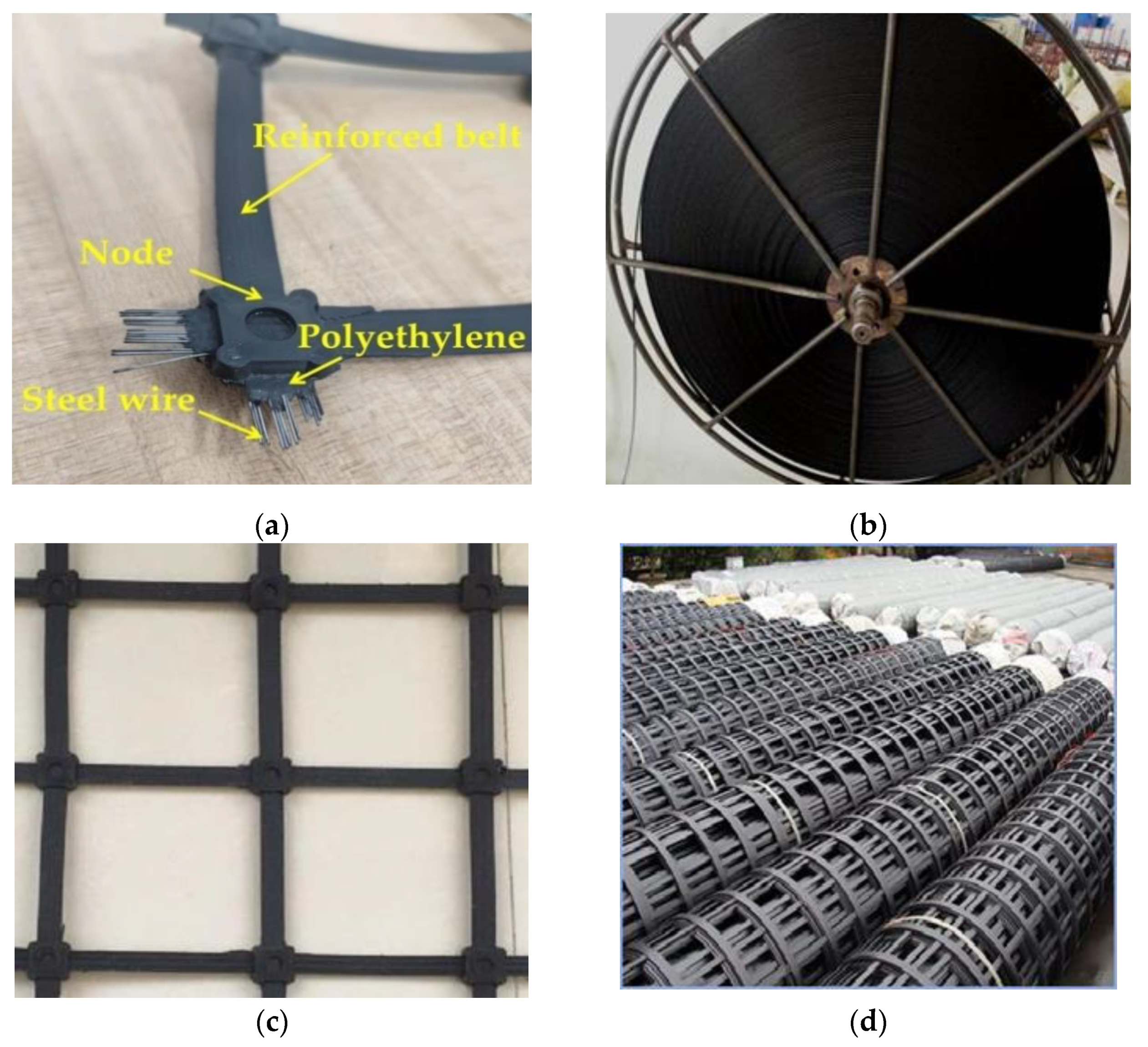

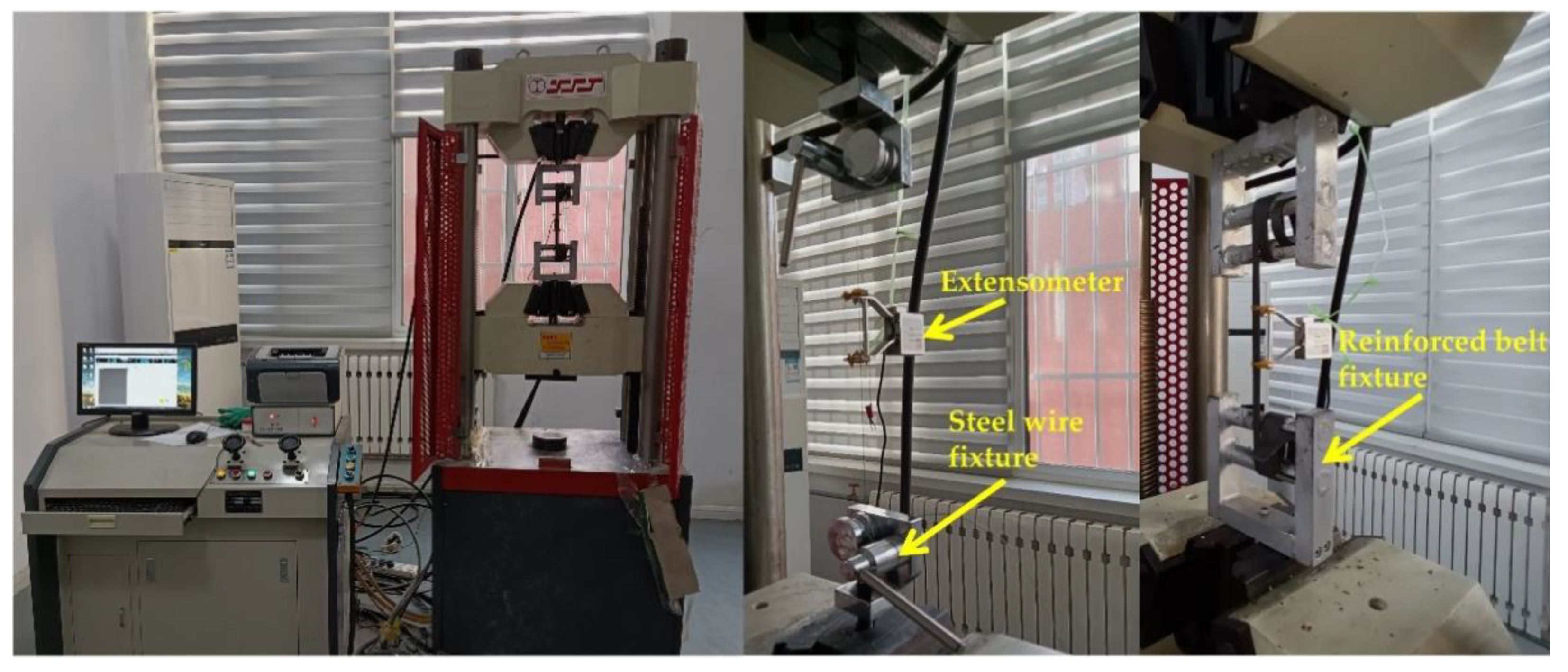
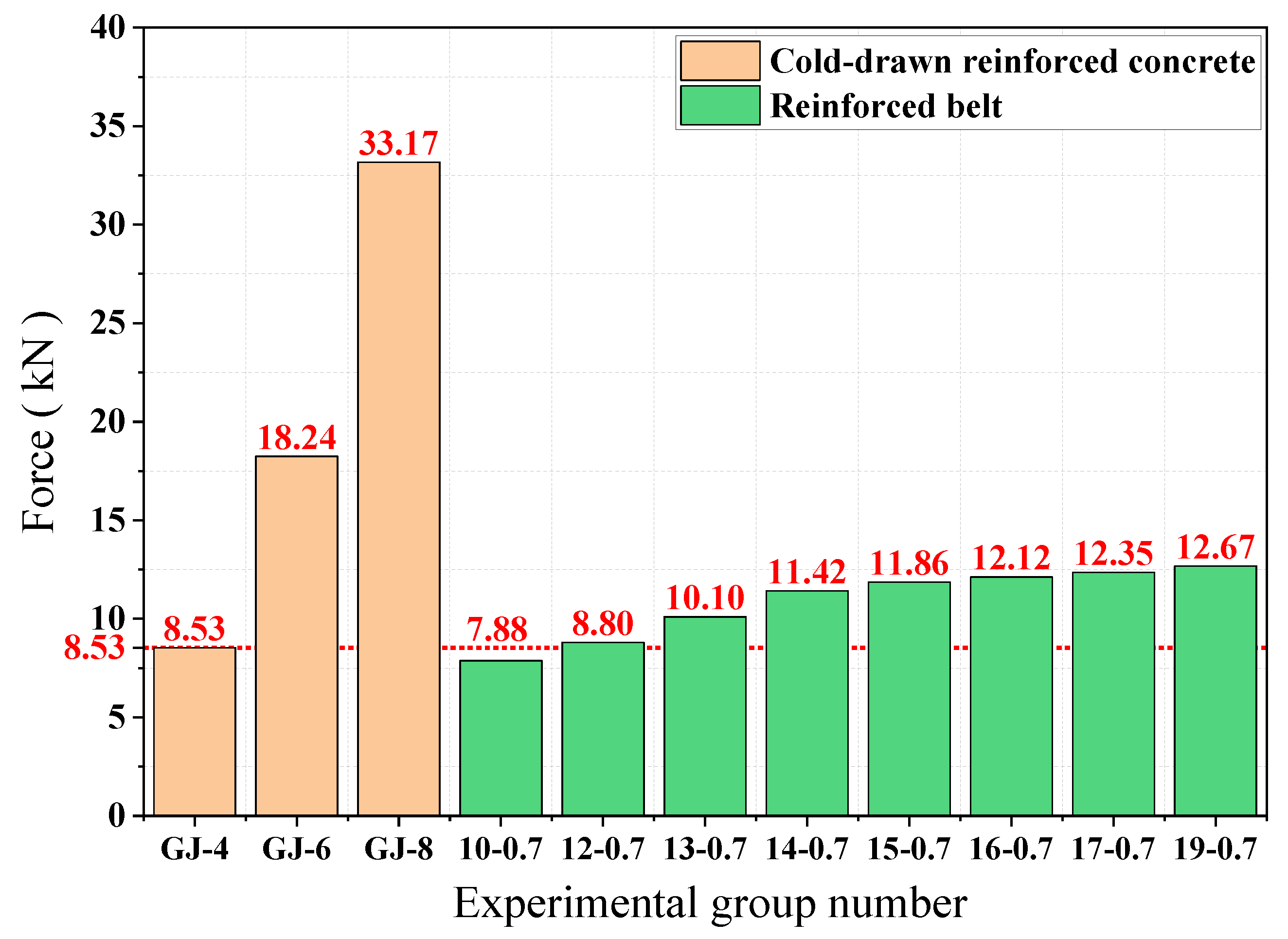
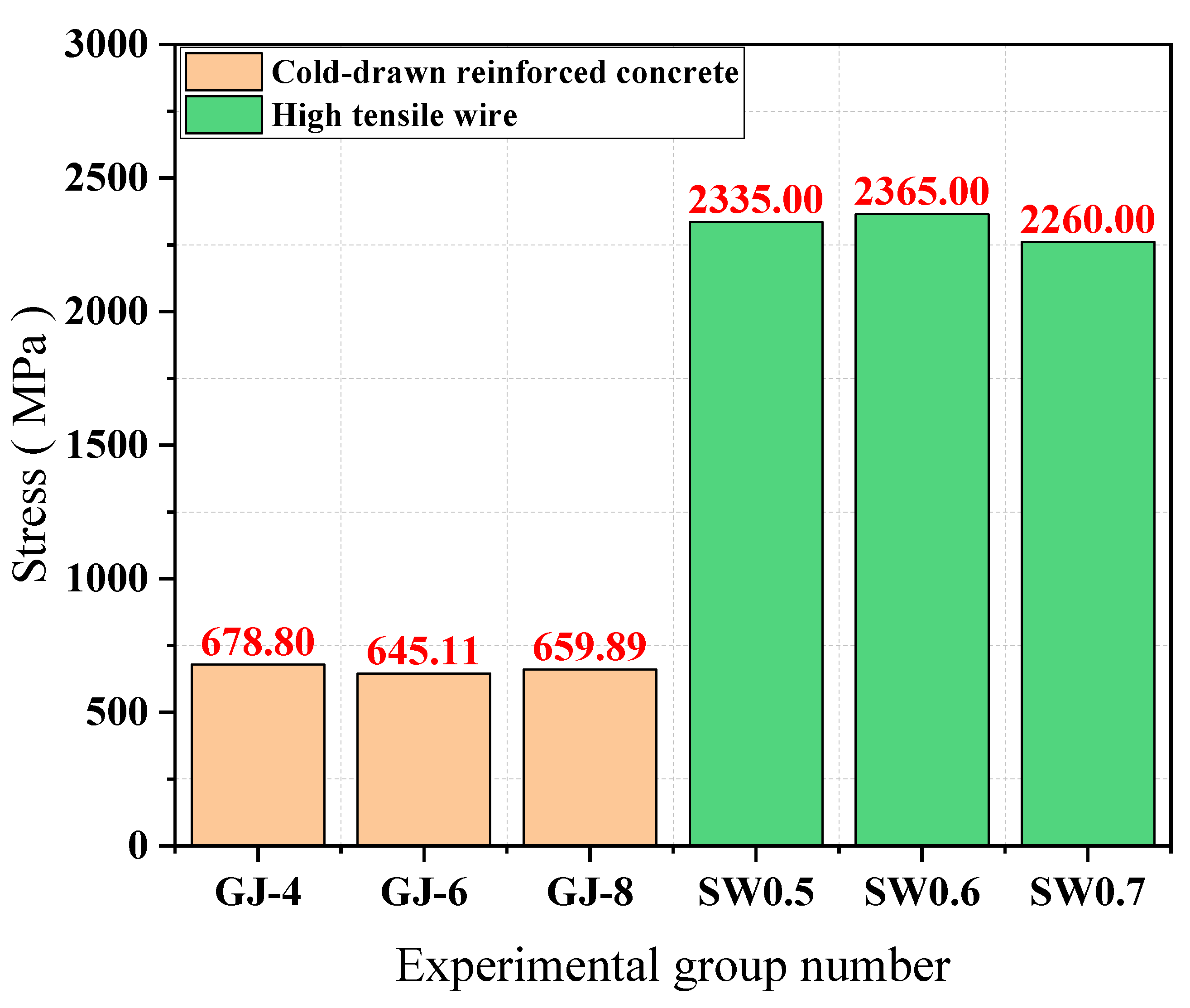
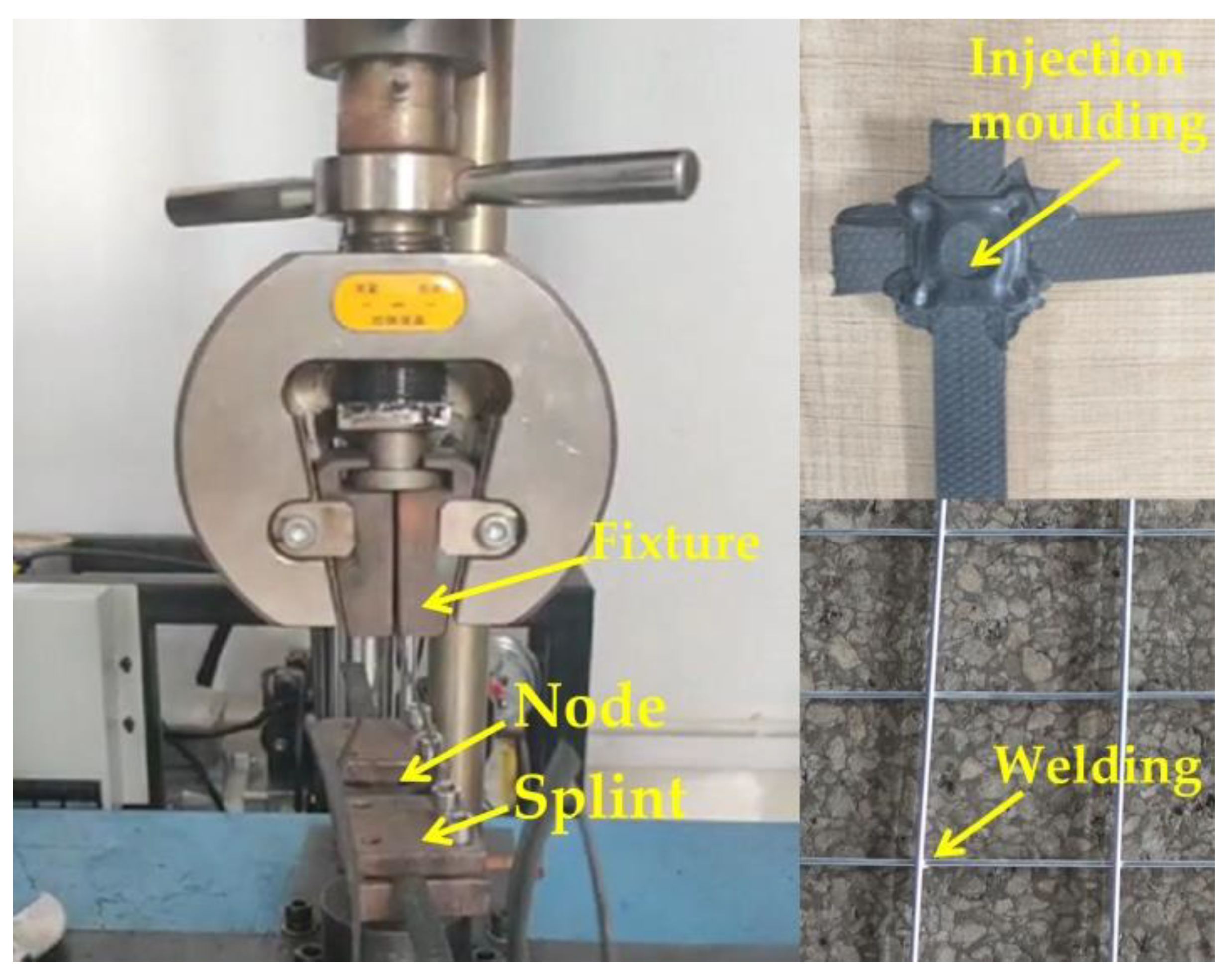

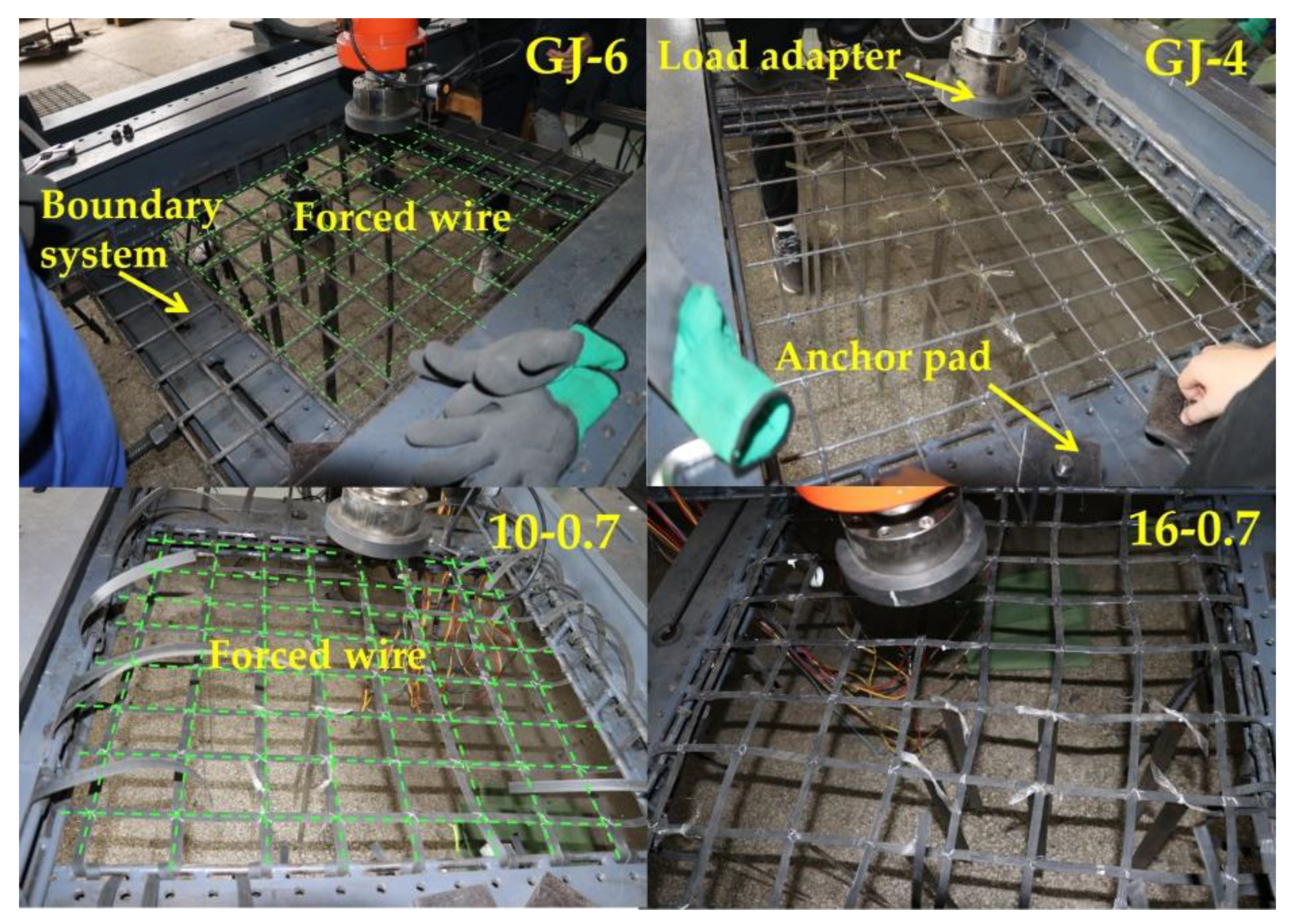
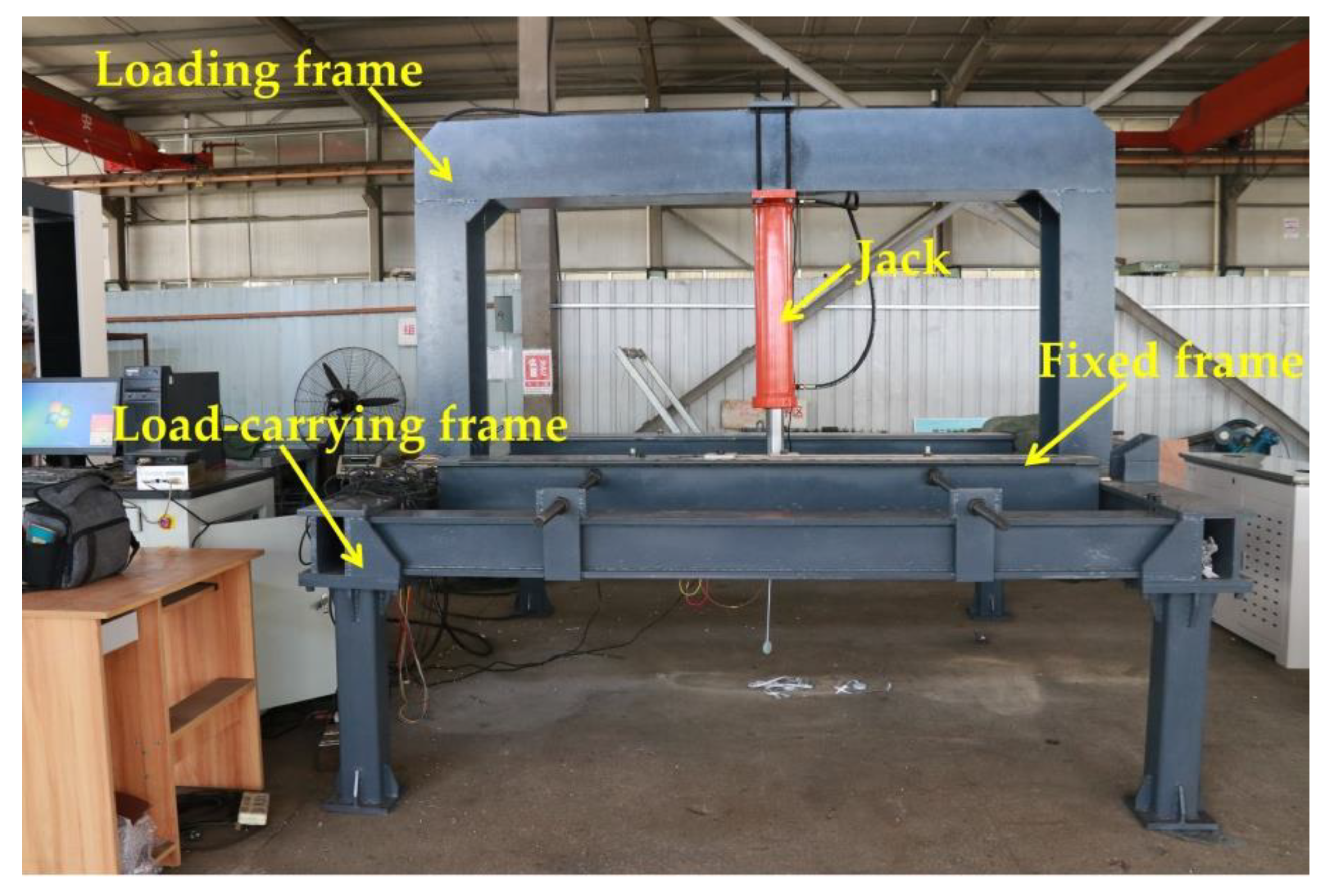
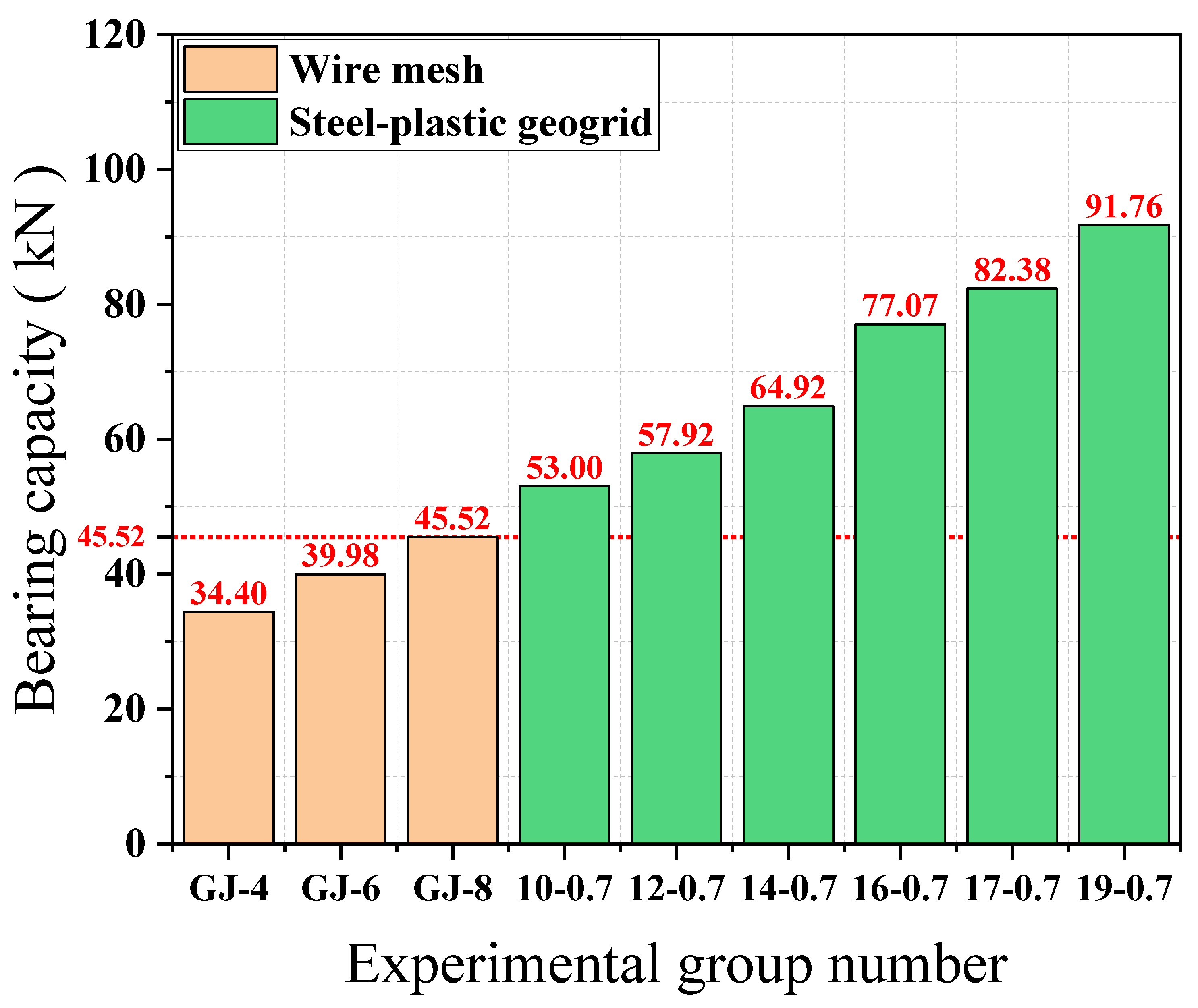
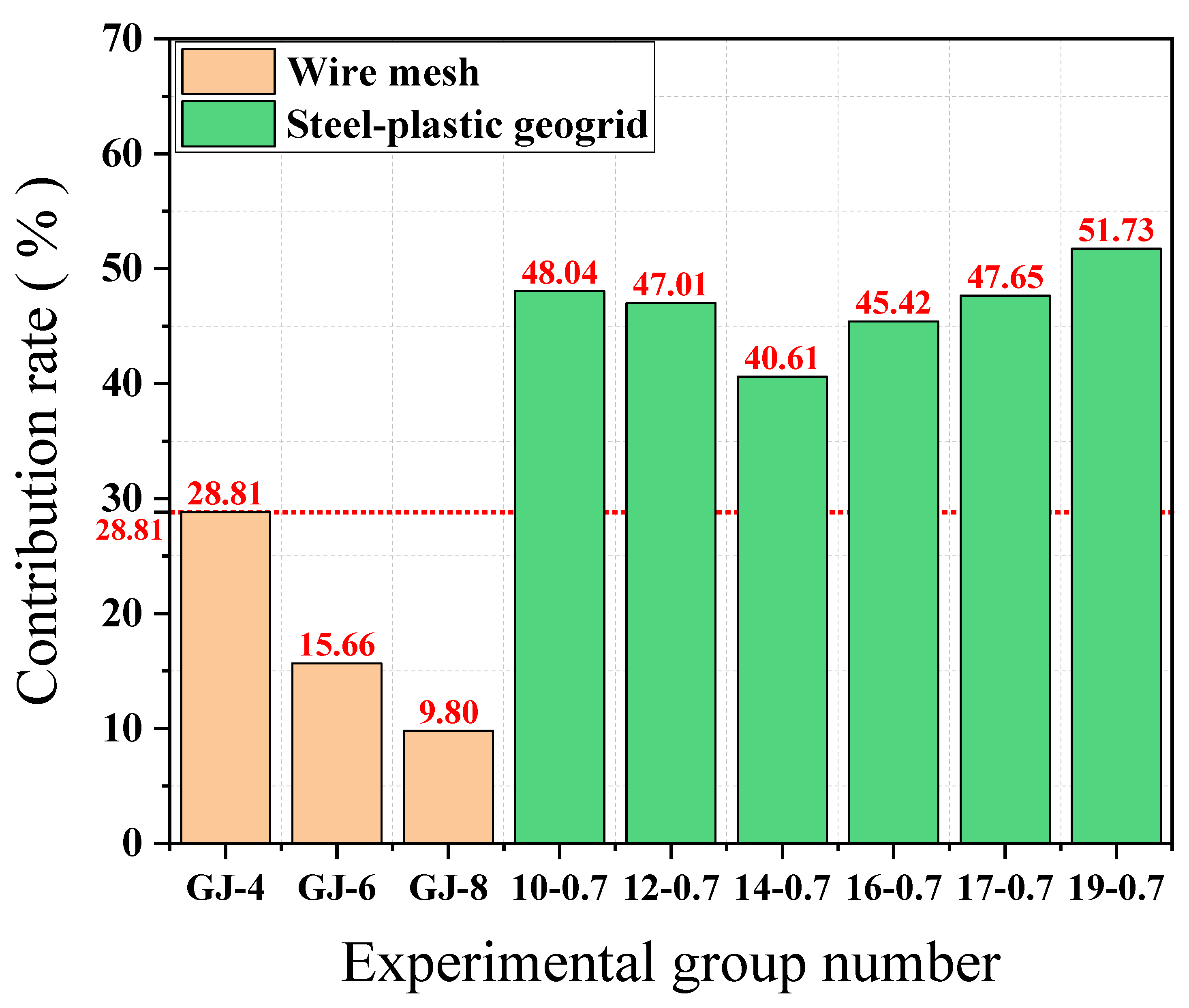
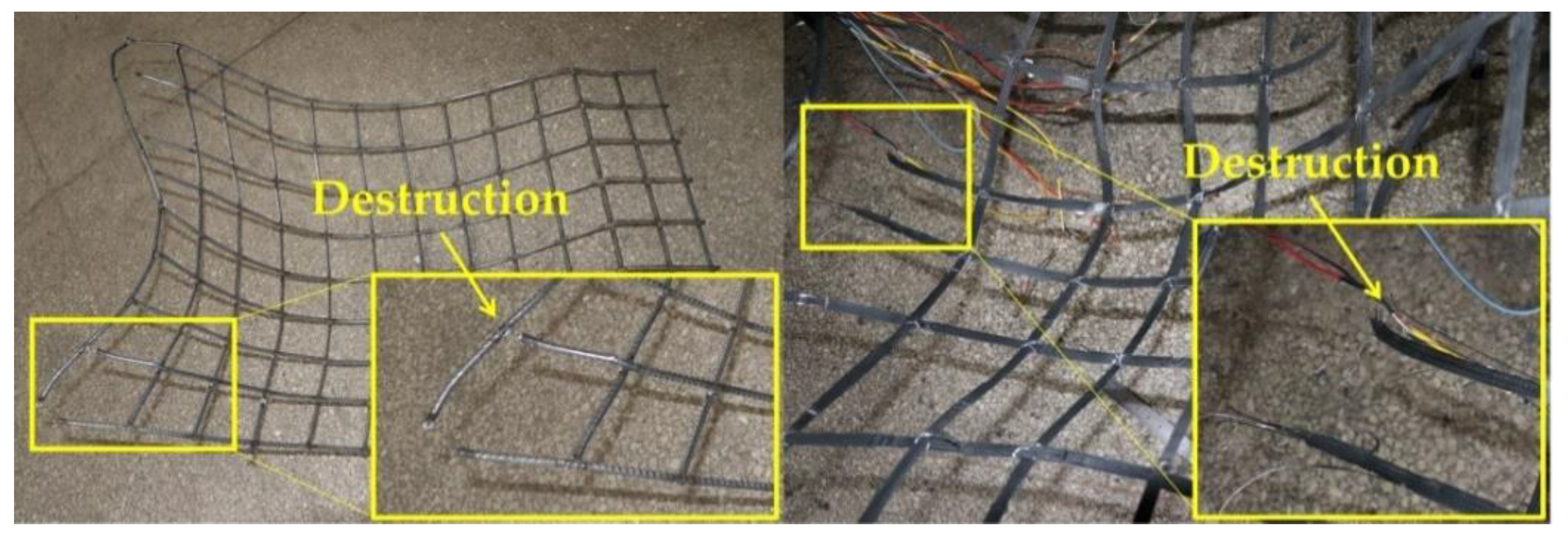
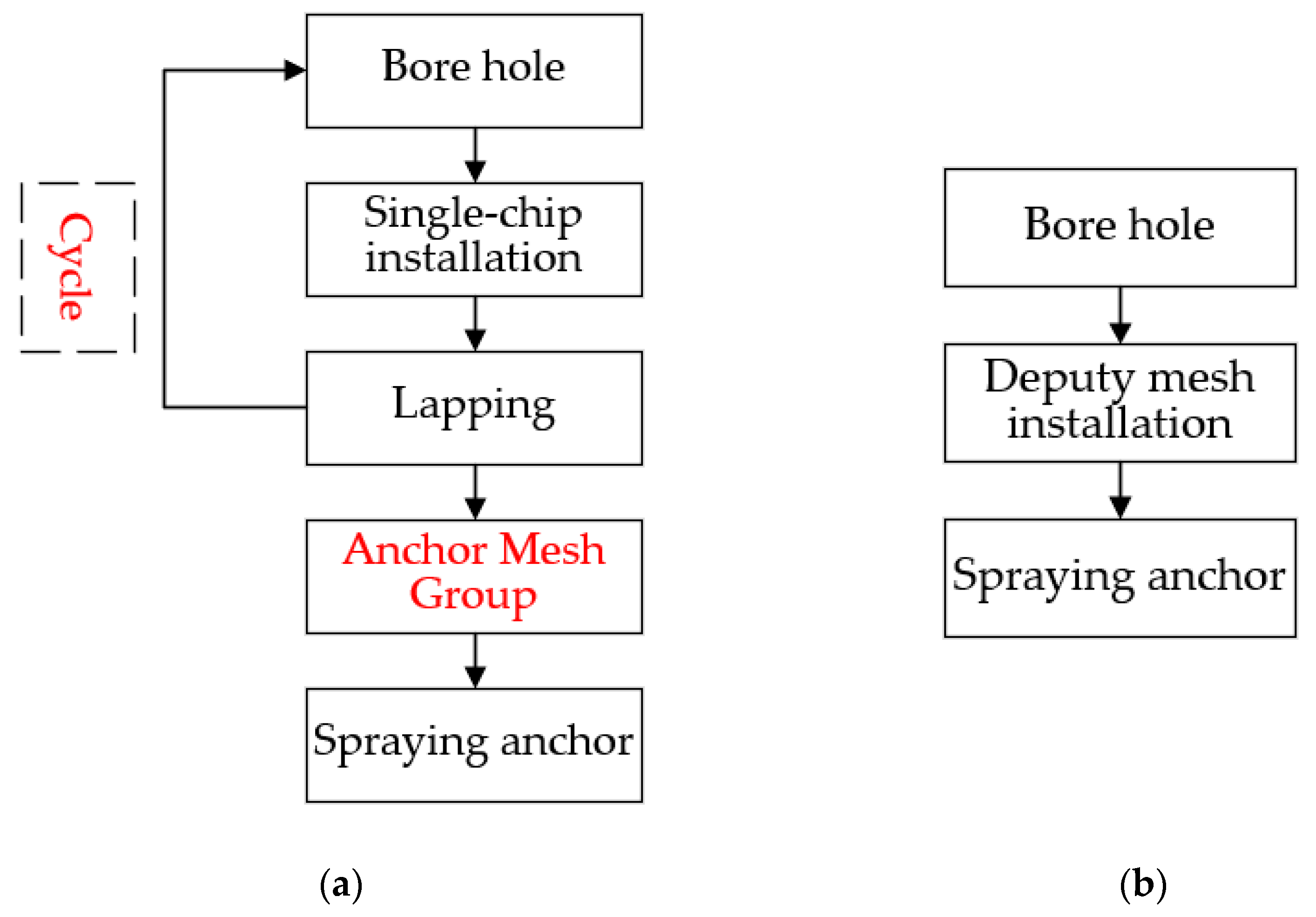


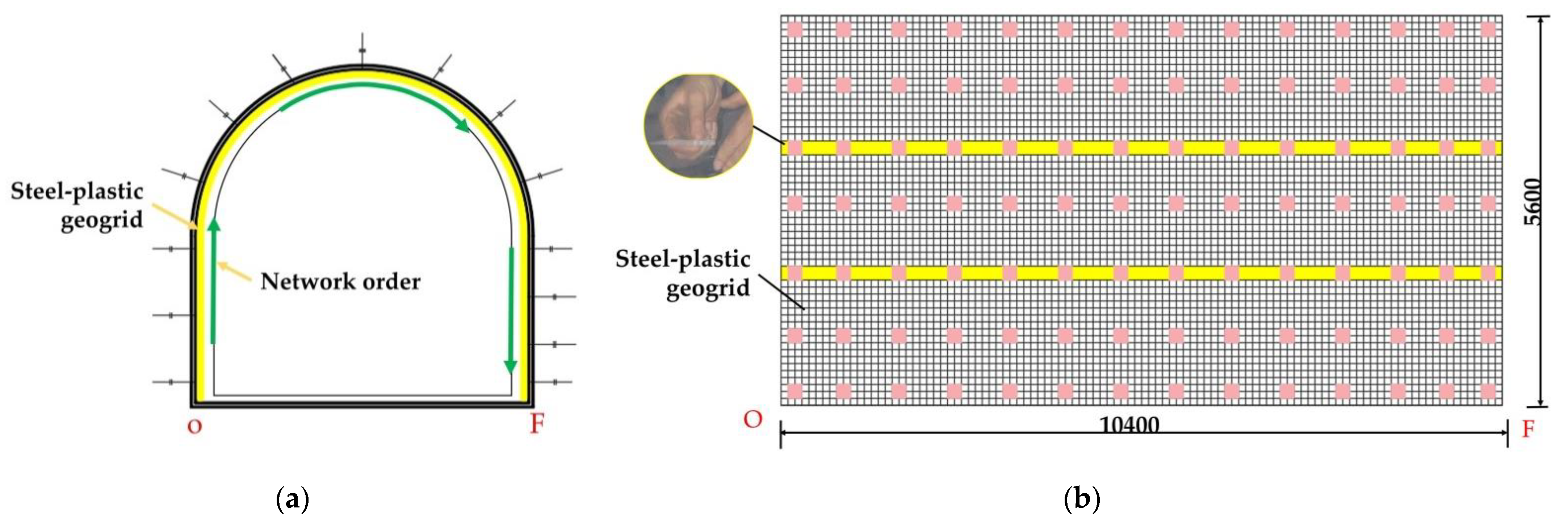


| Type of Material | Test Group Number | Number of Wires (rods) | Wire Diameter (mm) | Cross-Sectional Area (mm2) | Amount of Steel Used Per Unit Length (mm3) |
|---|---|---|---|---|---|
| High tensile steel wire | SW0.5 | / | 0.5 | 0.20 | 0.20 |
| SW0.6 | / | 0.6 | 0.28 | 0.28 | |
| SW0.7 * | / | 0.7 | 0.38 | 0.38 | |
| Cold-drawn steel bars | GJ-4 * | / | 4 | 12.57 | 12.57 |
| GJ-6 | / | 6 | 28.27 | 28.27 | |
| GJ-8 | / | 8 | 50.27 | 50.27 | |
| Steel-plastic geogrid reinforced belt | 10-0.7 * | 10 | 0.7 | 38.94 | 3.85 |
| 12-0.7 | 12 | 30.14 | 4.62 | ||
| 13-0.7 | 13 | 33.44 | 5.00 | ||
| 14-0.7 | 14 | 41.13 | 5.39 | ||
| 15-0.7 | 15 | 39.48 | 5.77 | ||
| 16-0.7 | 16 | 36.76 | 6.16 | ||
| 17-0.7 | 17 | 33.12 | 6.54 | ||
| 19-0.7 | 19 | 33.12 | 7.31 |
| Type of Material | Test Group Number | Connection Method |
|---|---|---|
| Cold-drawn steel bars | GJ-4 | Welding |
| GJ-6 | ||
| Steel-plastic geogrid reinforced belt | 10-0.7 | Injection-moulding |
| 14-0.7 | ||
| 16-0.7 |
| Type of Material | Test Group Number | Mesh Size (mm) | Grid Size (mm) | Actual Number of Mesh Wires Carried |
|---|---|---|---|---|
| Steel-plastic geogrid | 10-0.7 * | 800 × 800 | 100 × 100 | 14 |
| 12-0.7 | ||||
| 14-0.7 | ||||
| 16-0.7 | ||||
| 17-0.7 | ||||
| 19-0.7 | ||||
| Wire mesh | GJ-4 * | |||
| GJ-6 | ||||
| GJ-8 |
| Test Group | Test Number | Mesh Wire Tensile (kN) | Amount of Steel Used Per Unit Length of Mesh Wire (mm3) | Nodal Peel Strength (N) | Peak Mesh Load-Bearing Capacity (kN) | Contribution of Mesh Wire Carrying Capacity (%) |
|---|---|---|---|---|---|---|
| Steel-plastic geogrid | 10-0.7 | 7.88 | 3.85 | 1224.38 | 53.00 | 48.04 |
| 12-0.7 | 8.80 | 4.62 | / | 57.92 | 47.01 | |
| 13-0.7 | 10.10 | 5.00 | / | / | / | |
| 14-0.7 | 11.42 | 5.39 | 1154.56 | 64.92 | 40.61 | |
| 15-0.7 | 11.86 | 5.77 | / | / | / | |
| 16-0.7 | 12.12 | 6.16 | 1200.86 | 77.07 | 45.42 | |
| 17-0.7 | 12.35 | 6.54 | / | 82.38 | 47.65 | |
| 19-0.7 | 12.67 | 7.31 | / | 91.76 | 51.73 | |
| Wire mesh | GJ-4 | 8.53 | 12.57 | 988.35 | 34.40 | 28.81 |
| GJ-6 | 18.24 | 28.27 | 1728.46 | 39.98 | 15.66 | |
| GJ-8 | 33.17 | 50.27 | 45.52 | 9.80 |
| Mesh Type | Wire Mesh 1 | Steel-Plastic Geogrid 1 |
|---|---|---|
| Mesh size (m) | 2 × 1 | 2 × 10.4 |
| Number of meshes (pairs) | 39.00 | 3.00 |
| Mesh usage area (m2) | 78.00 | 62.40 |
| Overlap length (m) | 0.20 | 0.20 |
| Amount of anchors used | 98.00 | 98.00 |
| Support area (m2) | 58.24 | 58.24 |
| Average anchor use (/m2) | 1.68 2 | 1.68 |
| Mesh utilisation (%) | 74.67 2 | 93.33 |
| Overlap area (m2) | 17.68 2 | 4.16 |
| Percentage of overlap area (%) | 30.36 2 | 7.14 |
| Type | Wire Mesh | Steel-Plastic Geogrid | ||
|---|---|---|---|---|
| Time (min) | Number | Time (min) | Number | |
| Drilled holes | 8 | 98 | 8 | 98 |
| Installation of anchor rods | 1.5 | 98 | 1.5 | 98 |
| Mesh laying (m2) | 1 | 78 | 0.5 | 62.40 |
| Average lap time(m2) | 6.5 | 17.68 | 5 | 4.16 |
| Total time taken to hang the mesh in full section (min) 1 | 1123.92 | 983.00 | ||
| Average elapsed time (min/m2) | 19.30 | 16.88 | ||
| Type | Wire Mesh (Φ6) | Steel-Plastic Geogrid | ||
|---|---|---|---|---|
| Unit Price (CNY) | Number | Unit Price (CNY) 1 | Number | |
| Mesh (m2) | 26.4 | 78 | 11.6 | 62.40 |
| Number of anchor rods | 34.2 | 98 | 34.2 | 98 |
| Cost of lap material(m2) | 46.2 | 17.68 | 25.4 | 4.16 |
| Labour costs (min) | 0.5 2 | 1121.84 | 0.5 | 983.00 |
| Total | 6789.57 | 4672.60 | ||
| Average cost (/m2) | 116.58 | 80.23 | ||
| Key Projects | Steel-Plastic Geogrid | Wire Mesh |
|---|---|---|
| Mesh utilisation (%) | 93.33 | 74.67 |
| Percentage of lap joints (%) | 7.14 | 30.36 |
| Average construction time (min) | 16.88 | 19.30 |
| Average construction cost (CNY) | 80.23 | 116.58 |
Publisher’s Note: MDPI stays neutral with regard to jurisdictional claims in published maps and institutional affiliations. |
© 2022 by the authors. Licensee MDPI, Basel, Switzerland. This article is an open access article distributed under the terms and conditions of the Creative Commons Attribution (CC BY) license (https://creativecommons.org/licenses/by/4.0/).
Share and Cite
Wang, Q.; Wang, D.; Li, Y.; Liu, W.; Tian, C.; Shi, Z.; Wang, K.; Song, H.; Hu, Z.; Zhang, X.; et al. Feasibility Study on the Steel-Plastic Geogrid Instead of Wire Mesh for Bolt Mesh Supporting. Materials 2022, 15, 2281. https://doi.org/10.3390/ma15062281
Wang Q, Wang D, Li Y, Liu W, Tian C, Shi Z, Wang K, Song H, Hu Z, Zhang X, et al. Feasibility Study on the Steel-Plastic Geogrid Instead of Wire Mesh for Bolt Mesh Supporting. Materials. 2022; 15(6):2281. https://doi.org/10.3390/ma15062281
Chicago/Turabian StyleWang, Qingbiao, Dong Wang, Yue Li, Wenxia Liu, Chenglin Tian, Zhenyue Shi, Keyong Wang, Hongxu Song, Zhongjing Hu, Xu Zhang, and et al. 2022. "Feasibility Study on the Steel-Plastic Geogrid Instead of Wire Mesh for Bolt Mesh Supporting" Materials 15, no. 6: 2281. https://doi.org/10.3390/ma15062281
APA StyleWang, Q., Wang, D., Li, Y., Liu, W., Tian, C., Shi, Z., Wang, K., Song, H., Hu, Z., Zhang, X., Liang, X., Tang, F., Tang, X., Liu, Z., & Zhang, M. (2022). Feasibility Study on the Steel-Plastic Geogrid Instead of Wire Mesh for Bolt Mesh Supporting. Materials, 15(6), 2281. https://doi.org/10.3390/ma15062281








